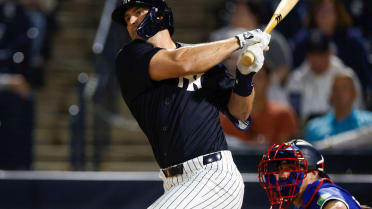So long, 2019. Of all the years we've seen, you were definitely ... one of the most interesting. Before we head off into a new year and a new decade, let's take one last look back at the season that was by calling out 10 of the most noteworthy plays of the year, Statcast-wise. That is: The most this, the highest that, and so on. In some cases, we'll need to get a little subjective to break a tie, but that's OK. Baseball is supposed to be fun. This one's going to be fun.
The longest home run of the year: 505 feet
Nomar Mazara, June 21
Of course we're starting here, because this one was an absolute blast, a laser off his bat at 109.7 mph straight down the line to right field. It wasn't just the longest homer of the year, it was tied for the longest tracked in the five years of Statcast.
"It feels good," Mazara said. "I’ve hit some balls hard, but that seemed to come off my bat quicker.”
Now, generally, balls hit down the line are a bit of a visual trick, because the foul poles are the shortest part of a stadium, and so balls hit there always look longer than they are. (For example, 400 feet to left field in Fenway is out of the park by 70 feet and onto the street. But 400 feet to center field in Fenway is probably caught by Jackie Bradley Jr.) That's what happened with this Yordan Alvarez blast in Houston that went "only" 415 feet, because the right-field pole in Minute Maid Park is a mere 326 feet away -- not to mention that his was hit higher than Mazara's, which is generally more visually impressive.
But in this case, Mazara's blast was every bit as far as it looked -- although teammate Elvis Andrus claimed he thought "it was more than 505 feet ... it was more like 600 feet," thus proving you can literally never satisfy everyone -- and that had a lot to do with the conditions that day. Several days before this game, a storm in Texas had damaged some of the wind screens at the ballpark, creating a serious jet stream effect headed out to right field. (As the quotes in this Athletic article reveal, the new park is specifically engineered to prevent such wind issues.)
It's worth noting that of the three homers projected to top 500 feet in the last five years, two were at Coors Field (Trevor Story's 505 in 2018, and Giancarlo Stanton's 504 in 2016), and the third was with a massive wind boost. It's hard to hit a ball that far without a little help.
The softest-hit home run of the year: 86.7 mph
Eugenio Suárez, April 11
Sergio Romo's fastball left his hand at 86.6 mph, and it left Suárez's bat at a nearly-identical 86.7 mph. We're not trying to disrespect Suárez here, because he mashed 49 homers, and if you get that many into the seats, you've probably had at least one or two favorable outcomes. Still, it's difficult to overstate how low 86.7 mph is for an over-the-fence home run; the average exit velocity in 2019 was 103.5 mph, and a mere 15 of them -- that's 0.2% -- were hit below 90 mph. (And even that includes some inside-the-parkers.)
That said, this one was all about placement. Suárez hit it directly down the line, a projected 340 feet, just barely over the wall in front of the foul pole marked as 328 feet. You'd think that this would only have been a homer in Cincinnati, but because of the placement, it would have actually made it out of 14 of the other 29 parks. If you can pop one ever so perfectly right around the pole, it doesn't always matter how hard you hit it.
This isn't all going to be about home runs, but while we're talking about Mazara destroying one and Suárez very much not, let's look quickly at the least likely one.
The least-likely home run of the year: Out in 1/30 parks
Alex Bregman, June 14
This is a tie, obviously. There's a handful of home runs that would have been out only in the park they were hit in that day -- here's a Brett Gardner ball to the short porch in Yankee Stadium that wouldn't have made it out anywhere else, and here's a Kris Bryant one that landed in the basket in Wrigley Field, and you get the idea. This happens, sometimes.
We've chosen the Bregman one because his was hit the most softly of any of them -- 89.8 mph, his third-softest Major League home run -- and because it felt appropriate to have one from the Crawford Boxes in Houston, the landing spot of so many unfortunate (for pitchers, anyway) dingers. This wasn't even a bad pitch, a 93 mph fastball on the hands, and it went just a projected 342 feet. This is an out in a lot of places. If we set aside direction and just look at distance, there were over 7,000 balls hit 342 feet or farther that were outs.
This is not the same as saying that Bregman only has power because of those short porches, for the record. He actually hit 25 homers away from Houston in 2019, and just 16 at home. It certainly doesn't hurt to have those boxes to aim at, though.
The outfield catch requiring the longest distance: 142 feet
Niko Goodrum, May 14
If Goodrum had run a completely straight and direct path to get this one, he would have done it in 138 feet. As it was, he ran 142 feet, which was close enough. Think about how long 142 feet really is, in baseball terms. It's the pitcher's mound to the plate, and back, and then halfway back again. It's home plate to second base, and then 20 more feet into center. It's running home-to-first, and then turning around and running more than halfway back home. It's a long distance, is the point, because Goodrum was playing in the left-center gap against Bregman.
Now, you can only get that far if you have a ton of time to do so, and Goodrum did, with 6.5 seconds of opportunity time. That doesn't sound like a lot, but it is. Count it down: One ... two ... three ... you get the idea. It's a lot. Still, this required great speed, because the combination of time and distance made it just a 45% Catch Probability, and Goodrum got up to a Sprint Speed of 30.8 feet per second. We consider 27 ft/sec to be average and 30 ft/sec to be elite, and this was Goodrum's fastest of the season -- and one of just two times he topped 30 ft/sec.
This came ever-so-close to being the longest run for an out on record (dating back to 2015), actually. In 2018, Ender Inciarte ran all the way from center nearly to the infield to catch a popup, where he ran ... 143 feet. So close, Niko. So close.
The least likely hit of the year: .010 Expected Batting Average
Manny Machado, June 19
There's a few of these that happen each year, the kind of absolutely-no-shot-for-success ball that falls to the ground in such a disastrous manner that the official scorer can't even call it an error, even though it's very much a defensive mistake. This Machado ball was hit at a mere 75.5 mph at a 77 degree launch angle, but the numbers there aren't terribly relevant. He hit it straight up. This should always be an out. In the five years of Statcast tracking, there have been 3,559 balls hit at a 70 degree launch angle. Eight have been hits. Eight!
We chose Machado's over the others -- here's where the subjectivity comes in -- because it was visually hilarious, and because it mattered in the game. San Diego was down 7-5 in the seventh inning at the time, and this should have been an easy first out. Instead, Machado reached, Hunter Renfroe walked, and then Franmil Reyes crushed a three-run homer, giving the Padres an 8-7 lead on the way to a sweep. Bonus: It wasn't even the weirdest Machado play of the day, because in the second, he thought he'd hit a homer before it turned out it was only a single.
The visual part is because there were five different Brewers looking at this one with a chance to make the catch, and while this was obviously a case of simple miscommunication, that's still more than half the defense, and this one had a direct impact on the game.
Entertainingly, when we did this last year, we looked at an Alex Bregman walk-off hit on a botched popup, and that one came against ... the Padres. We'll call this even.
Now, one of the others we could have chosen here was from Baltimore's Pedro Severino, who had a similar thing happen against the Royals. Mid-tier catchers in a game between two teams that combined for 211 losses don't generally rate much regard, but we're noting him here because ...
The fastest pop time to second base: 1.75 seconds
Pedro Severino, June 9
Severino actually had a really interesting season, at least from this view. (He also somehow hit three homers in a game in Texas, two weeks before Mazara's shot, but also almost blew a 12-11 lead with a near-passed ball on the final pitch.)
Acquired on waivers from Washington just before the season began, Severino was a decent league-average bat (97 OPS+) for the O's, but on June 9, when he nabbed Tony Kemp trying to steal second base, he did so in a mere 1.75 seconds, the fastest pop time (to second) of anyone in in 2019. That also gets him on the Top 10 all-time (since 2015, obviously) list, with a J.T. Realmuto 1.65 second throw from 2017 at the top. It wasn't even necessarily the most on-target throw, because it required Richie Martin swiping back to the other side of the bag, but it was fast. It was so fast.
The slowest home run trot with the best reason: 34.23 seconds
Rhys Hoskins, April 24
Two caveats, here. First, we're only looking at obvious homers, not things like Jarrod Dyson taking nearly 46 seconds because it wasn't clear if his March 30 ball had actually cleared the fence or not, so he paused at second base -- there were a few of those. Second, we're not including Ketel Marte taking 35 seconds to circle the bases on Aug. 27, because he'd injured his hamstring on the swing and grimaced all the way around. It was slower, barely, but also not in the spirit of what we're looking for.
Setting those aside, the slowest home-to-home trot without an excluding reason was also probably the most satisfying one of the season -- Hoskins purposefully doing his best to infuriate the Mets and their fans on his ninth-inning blast in Queens. The backstory of this, in case you've forgotten: The previous night, the Mets and Phillies had traded hit-by-pitches, nearly causing the benches to clear, and Hoskins had watched two pitches from Mets righty Jacob Rhame fly over his head.
On this night, Rhame and Hoskins faced off again, and Hoskins won, hitting what must have been a most satisfying home run to left field. The 34.23 seconds wasn't just the slowest of the season, it was the slowest home run trot of the five seasons of Statcast, setting aside again those with obvious outlier reasons.
Hoskins didn't seem terribly interested in saying he was out for revenge, but it's essentially impossible to watch this and not realize what was going on. Personally, we approve. You hit it out of the park, you get to take your time.
The fastest home-to-first time: 3.34 seconds
Terrance Gore, June 21
Let's go from slow to fast, and it's extremely satisfying that Gore is the name that comes up here, because Gore exists in professional baseball almost entirely to run. In parts of six Major League seasons, Gore has 40 steals ... and 77 plate appearances. He's got only 15 hits, 14 of them coming in 2019; despite making his Major League debut in 2014 and appearing in seven different playoff series, he didn't make his first appearance in a starting lineup until 2019.
He's fast, is the point, coming in as the 9th-fastest player in 2019, though really in something of a giant tie for third. This one had all the ingredients for a great home-to-first time, because not only does Gore possess the obligatory elite speed this requires, it was also a bunt attempt, meaning that he already had some forward motion on his way to first when he made contact, as opposed to needing to uncoil after a swing. Some credit is perhaps due to third baseman Miguel Sanó here, because he actually made this look a lot closer than it had any business being.
If we look back to 2016 here, this is the second-fastest home-to-first of the last four years, just a fraction of a second behind the 3.33 that José Altuve put up on a similar play in 2017. You might call it a tie if you wanted to. We'll call it fast either way.
The hardest outfield throw for an assist: 100.8 mph
Greg Allen, Sept. 18
This wasn't the hardest tracked throw of the year; that was Aristides Aquino posting a 101.5 mph laser on Aug. 8. But that one was a throw without any particular consequence, because the runner advanced to third base. This one was the hardest-tracked assist of the season, and it was a big deal. This one came with a runner on second in the fourth inning of a tie game, and Allen's throw kept it that way. It would stay that way, in fact, all the way through the 10th inning, when Yasiel Puig's walk-off hit kept the Indians within a half-game of the second AL Wild Card spot.
“Sometimes you just surprise yourself, whether it’s how hard you hit a ball or make a throw like that,” Allen said. “It’s funny, one of the guys was coming up after the inning, they asked me jokingly how hard I thought I threw that ball and I’m just like, ‘I don’t know, maybe 88-90 [mph]?’ Like, no. I had a chance to see the Statcast on it. That was pretty neat, for sure. We’ll see how many bullets I got left in the arm.”
Best jump on an outfield catch: (+11.6 feet above average, or 45.4 feet total)
Harrison Bader, April 29
When we introduced "Jump" as a Statcast metric in June, it was with the intention to measure outfield skill beyond just top speed, because there's obviously more to it than that. There's reactions, acceleration, and doing it all in the right direction. That's what makes for a good jump or a poor one. Often, it's impossible to judge with the eye test, especially on television, where the camera often cuts to the outfielder well after those initial movements are made.
So "Jump" is defined as how many feet above average a fielder moves in the right direction in the first three seconds, and it can make or break a play. (It's very unsurprising to see Kevin Kiermaier at the top of the seasonal leaderboard.) On this play, Bader moved 45 feet in the first three seconds, all in the right direction, and that was nearly a dozen feet more than average. Think about how big of a deal 12 feet is -- it's twice the length of Bader himself, given that he's listed as 6'0". It's the difference between getting to a ball and having no chance whatsoever.
You can't exactly see the jump itself in the video, because televised baseball doesn't usually work like that. But this does help explain how a play that looked nice -- he did leave his feet, after all -- but not otherworldly difficult actually came in with a mere 10% Catch Probability, making it one of the toughest plays of the year. If Bader had merely an average jump, he'd have been 12 feet away, with no shot. If he'd had a below-average jump, maybe he's 15 feet away and this ball gets past him for extra bases. There's a reason Bader is one of baseball's best outfielders, and why great catches are great for reasons beyond just how cool they look. From the first fraction of a second, Bader is moving in the right direction.
Mike Petriello is a stats analyst for MLB.com, focusing on Statcast and Baseball Savant, and is also a contributor to MLB Network.




